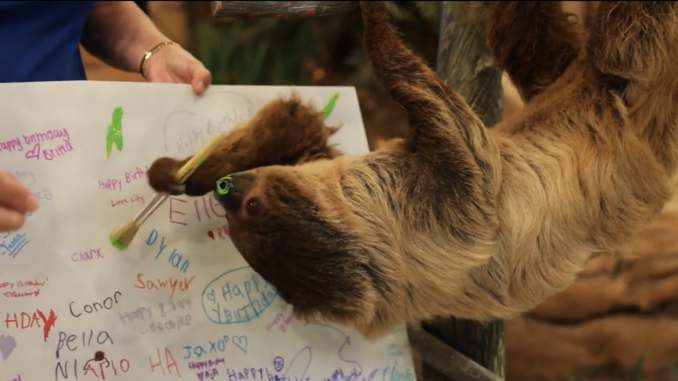
Emma Polen | Editor-in-Chief
The National Aviary of Pittsburgh celebrated their slowest birthday party of the year, with two of their resident two-toed sloths – Vivien, 6, and Wookiee, 23 – aging up last week.
Visitors could participate in many hands-on activities in celebration of the sloths, which included signing Wookiee and Vivien’s birthday card, coloring sloth headbands and singing happy birthday while special cakes were presented individually to the birthday sloths.
Each sloth’s cake included a variety of their favorite treats. Christa Gaus, senior manager of animal programs at the National Aviary, shared that the special sloth cake recipe includes hibiscus flowers, nutritious biscuits, and icing made out of sweet potatoes and leafy greens.
The National Aviary hosts three linnaeus two-toed sloths, characterized as such by their two front claws.
The birthday festivities concluded when the aviary’s third two-toed sloth, Valentino, signed the birthday card. Gaus called him “Leonardo Slow-vinci” due to his fascination with art and painting.
Gaus has worked with animals at the National Aviary for a total of 17 years. In fact, even before starting at the aviary, she already knew Wookiee the sloth.
“[We] go way back,” Gaus said.
During her work with the animals, Gaus has observed the unique personalities of the creatures, even within the same species.
While sloths are considered solitary creatures, they all interact with their trainers, each other and their enclosure differently.
Vivienne the sloth appreciates her routine and her behavior is more cautious, Gaus said, while Valentino is more curious, and tends to offer more behaviors, including his painting.
Even the sloths’ birthday cakes were customized to their specific taste. Wookiee prefers carrots and green peppers, while Vivienne prefers other vegetables for her dinner.
Behind the scenes, aviary staff are working to cater to animal preferences and build trusting relationships, and this comes with understanding their natural history and integrating as much natural care as possible into daily observations.
Gaus said her job becomes even more rewarding when she and the other trainers at the aviary have a breakthrough with one of the resident animals.
A frequent patron of the aviary, Terri visited the aviary often enough to notice the sloths’ different behaviors as well.
“Sometimes Wookiee hides,” she said, but for his birthday, the sloth was not shy. The frequent visitor said she has always been fascinated with sloths, and she is proud to have three right in the Pittsburgh area.
“He is magic,” Terri said as Wookiee steadily climbed across the branches. “They move a lot faster than you think.”
Terri, who declined to give her last name, has made the trip to the Aviary several times, and even had the chance to make Wookiee his dinner during one special experience. “If I lived down here [in the city of Pittsburgh], I would work here,” she said.
“We love sloths,” said Amanda Isenberg and her daughter, Amira. They visit the aviary a couple times a year. Amira brought her long-time friend, Slothy – a stuffed sloth who has seen lots of love — and she was sporting a tie-dye sloth shirt. Isenberg said back at home, Amira has a sloth-themed bedroom, too.
“Truly a sloth fanatic,” Isenberg called her.
The reason for getting guests to “celebrate the animals we have here,” Gaus said, was, at its core, to “inspire conservation efforts.”
Conservation efforts for the National Aviary promote teaching visitors about the animals they see, and to solve several misconceptions about the animals.
For example, sloths move slower to conserve their energy, but they can actually move about 6 feet per minute, which is equivalent to a human running a slow-paced jog, Gaus said.
“Focus on what we do in front of desks, but also our conservation efforts behind the scenes,” Becca Hansborough, the content and communications manager at the National Aviary. More information about the aviary’s efforts can be found at aviary.org/conservation.
